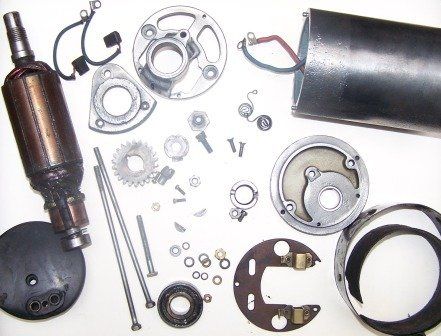Dynamos
Dynamos*
Dynamos usually come to us because ‘it's not charging’ – although we often find that the problem is not with the dynamo but with the voltage regulator/cut-out. The first step is to try to ‘motor’ the dynamo. If it fails to motor, the dynamo is definitely faulty and it needs to be taken apart. If the dynamo does motor, it only shows that it might be OK. The motor test on it's own is not conclusive, but it will automatically polarise the pole shoe(s) carrying the field coil(s) ready for the next test. This is done on the Octopus Electrical Test Bench. The dynamo is run up to normal operating speed and the voltage output checked without and then with a load connected. If all is OK, attention is directed to the voltage regulator/cut-out, but if not the dynamo is stripped and cleaned, and the component parts individually checked.

Lucas E3L dynamo in parts
Field coils are checked for continuity using a standard digital multimeter followed by a 500 volt insulation test between the field coil and the dynamo body. If the field coil is found to be faulty it is removed and replaced using the correct tools – a pole shoe spreader
and pole shoe screwdriver. Armatures are tested using a DC volts drop test on a Kenyon type Armature Tester
and/or AC tested using a Newton Growler. Final electrical tests on the armature involve insulation tests between commutator segments and core. Brushes are checked for wear and free movement in the holders. These tests should highlight any defective component. A repair is carried out or a replacement fitted, as appropriate. The dynamo is then reassembled, usually with new bearings fitted with rubber seals, and finally checked once again on the Octopus Electrical Test Bench.
A few other things related to dynamos:
- Replacement armatures and field coils for the most common dynamos are readily available at a reasonable price. For this reason we don’t rewind them, but use new components if necessary. However, if you have one of the more obscure types, don't worry - they can be rewound!
- A common job is to convert the older three brush dynamos
to two brush operation. This results in a far more efficient dynamo but it is always done in such a way that it can be converted back to three brush operation if required at a later date.
- We are often asked about 12v conversions
and there are a number of ways in which this can be achieved. As with most things, there will always be a trade-off between efficiency and cost – the very best system costs the most money.
Please talk to us
about the options so that you can make your own mind up.
The Magneto Guys
Telephone: +44 (0)1323 840203
